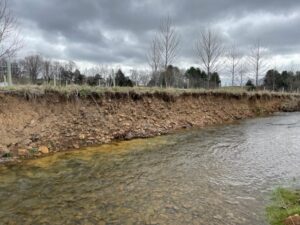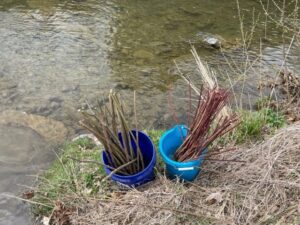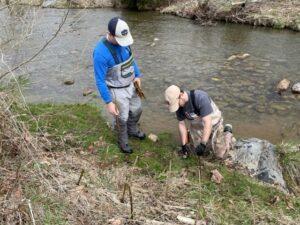In March, staff had the opportunity to volunteer with the Chesapeake Bay Foundation installing live stakes along a section of Kerrs Creek in Rockbridge County. Live staking, as it’s referred to, is a cost-effective conservation technique used to stabilize streambanks and reduce erosion during rain events. The process involves cutting limbs from a live tree or shrub, and then replanting the limbs, or stakes, in areas with little vegetation.
So, wait. Does planting these things really work? They don’t even have roots!
Well plants are pretty incredible organisms! These stakes have the ability to sprout roots to establish a new tree. This article from Penn State Extension does a great job of explaining how the whole process works.
It was a really great event to be involved in. Staff worked with students from Washington and Lee who were looking to give back to the community and take knowledge gained in the classroom and apply it to real-life projects. It was great to get to know some of them and talk about their experiences as students looking to get into the environmental field after graduation. In total, the group planted over 300 (!) live stakes in just under four hours.
The planting is a small part of a larger effort being done to improve riparian forest cover in the Chesapeake Bay Watershed. Riparian areas serve as the interface between a waterway and the adjacent land. These areas play a critical role of ensuring that aquatic and terrestrial systems are connected.
A healthy, undisturbed riparian zone will be forested and at least 50 feet wide. These zones are able to ‘buffer’ impacts of land use on a stream system by capturing nutrients and stormwater that may runoff during a rain event. Riparian zones can also stabilize streambanks, help control stream temperatures, and provide food for aquatic organisms. They provide habitat for birds and waterfowl and can serve as wildlife corridors that allow for animals to safely move from place to place and limit habitat fragmentation.
Stabilize streambanks: Tree and plant roots are great at holding soil in place. This is especially important along streambanks that allow water to rip into loose sediment and unprotected soils. By having root structure in place, soil is prevented from washing downstream after rain events.

Stakes were planted along this cut bank to help with stabilization. Tree plantings in the background will help establish a wide buffer.
Control stream temperature: Tree canopy provides shade over a stream to help cool it during hot, summer days. This is especially important if the stream is home to cold water species, like Eastern Brook Trout, that are sensitive to warmer temperatures. Cooler water holds more dissolved oxygen, which is vital for maintaining a diverse community of organisms.
Food for aquatic organisms: Not only will fish be treated to spiders and other bugs that happen to fall off a tree limb, but the tree parts themselves will serve has food for aquatic macroinvertebrate species, or aquatic insects. Some of these species are referred to as ‘shredders’, meaning they consume coarse particulate organic matter like leaves. Shredders also help provide food for insects who are called ‘collector-filterers’. These species collect the bits and pieces of organic matter, like the shredded leaf material that got away, that are caught up in streamflow. These insects are the main food source for many fish species.
Habitat and wildlife corridors: Many bird and waterfowl species find sanctuary in forested areas next to waterbodies, and it’s not just your common sparrow. Bald Eagles prefer to live along waterways so they can have easy access to their favorite meal – fish. Riparian zones allow eagles to build nest in trees located in close proximity to waterbodies. Wildlife also use waterways to navigate between landscapes. The natural ‘roadway’ allows for animals to travel from different areas to access food, escape predators, or reach breeding grounds. Even some aquatic insect species, specifically case-making caddisflies, will use twigs and leaves from riparian trees to make cases for protection and molting.
There are many benefits to having these areas forested and undisturbed. Much of them have been cleared for agricultural purposes or development, but there is an ongoing effort to restore riparian zones and their functions.
This particular planting was funded by one of the many buffer restoration programs available for landowners and communities. The James River Buffer Program offers the chance for landowners to install trees in riparian areas for no cost. The program is spearheaded by three organizations: the James River Association, Chesapeake Bay Foundation, and Virginia Department of Forestry. Landowners in the Middle and Upper James Watershed are eligible for the program. This area is generally defined as the section of the watershed west of the Fall Line in Richmond extending to the headwaters in Highland County. Projects on public lands are also eligible. You can find out more by visiting the website here. Be sure to connect with the program coordinator if you are interested in volunteering!


